<> Papilio clytia (Linnaeus, 1758) <>
the Common Mime ผีเสื้อเชิงลายธรรมดา
Click on any photo to see all photos full size in Lightbox
Additions and corrections to the information provided on this page is always welcome. Please use the Contact form.
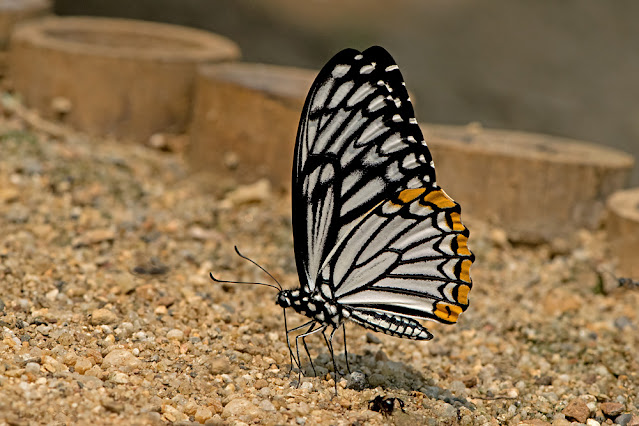
Photo taken at Chiang Dao Nature Sanctuary, Chiang Mai, Thailand. 540m a.s.l.

An interesting and variable species that is widely distributed throughout most of the region. Although there is only one continental subspecies there are a number of different forms in two form groups, brown and black striped. Two of the most common forms, papone & dissimilis, mimic distasteful Danainae butterflies and are strong and graceful flyers. Both sexes visit flowers and the males are avid mud puddlers seen regularly along the banks of streams.
Papilio clytia is multivoltine with several broods per annum. The adult female lays her eggs singly or in small groups on the upperside of leaves on the host plant. The caterpillars possess an osmeterium (a fleshy forked organ) in the prothorax. Usually hidden, the light blue osmeterium can be everted rapidly and emits a foul-smelling secretion if the caterpillar is disturbed or feels threatened. The pupae of this species are unique in that they resemble a dead twig and are therefore excellently camouflaged.
Synonyms and previously used names: Chilasa clytia, Papilio dissimilis, Papilio panope, Papilio papone, Papilio casyapa, Papilio lankeswara, Papilio saturata, Papilio onpape, Chilasa clytioides, Arisbe similis
Taxonomy: Animalia - Arthropoda - Insecta - Lepidoptera - Papilionidae - Papilioninae - Papilio - clytia
Regional subspecies: P.clytia clytia (India, Myanmar, Thailand, Laos, Cambodia, Vietnam, China, W.Malaysia, Singapore). There are a number of other subspecies that have been listed throughout the islands of Indonesia and the Philippines but there doesn't seem to be a consensus of opinion on the validity of these subspecies. More study is needed.
Regional Distribution: India, Nepal, Bhutan, Bangladesh, Myanmar, Thailand, Laos, Cambodia, Vietnam, S.China, Malaysia, Singapore, Indonesia, Philippines
 |
Chiang Dao Nature Sanctuary, Chiang Mai, Thailand. f.papone 540m a.s.l. |
Habitat: Papilio clytia is predominantly a forest species and is found in rainforest and moist evergreen and deciduous montane forest, usually near streams at moderate elevations. However, they are also seen in grassland, sometimes in urban gardens, and have been recorded at elevations up to 2700m a.s.l. in certain locations.
Flight time: most of the year, depending on location. Wingspan: 75-1mm
Life History: egg 3-5 days instar 1 2-4 days instar 2 2 days instar 3 2-3 days instar 4 3-4 days instar 5 4-5 days pupa 13-17 days Total egg-adult 29-36 days. All times are approximate.
Larval Hosts: Alseodaphne semecarpifolia, Cinnamomum bejolghota, Cinnamomum camphora, Cinnamomum iners, Cinnamomum macrocarpum, Cinnamomum tamala, Cinnamomum verum, Cryptocarya amygdalina, Litsea coriacea, Litsea glutinosa, Litsea ligustrina, Litsea monopetala, Litsea rotundifolia, Litsea tomentosa, Machilus gamblei, Machilus glaucescens, Persea macrantha, Phoebe lanceolata (Lauraceae), Elaeocarpus angustifolius (Elaeocarpaceae), Sarcosperma arboreum (Sapotaceae), Ficus hispida (Moraceae).
Actual host plant used depends upon location and availabilty of plant species.
Adult Food Sources: Nectar - Jatropha integerrima (Euphorbiaceae), Bidens alba, Bidens pilosa, Cosmos sulphureus, Sphagneticola trilobata (Asteraceae), Duranta erecta, Lantana camara, Stachytarpheta cayennensis (Verbenaceae), Ixora coccinea, Ixora javanica, Mussaenda frondosa (Rubiaceae), Caesalpinia pulcherrima, Cassia sp., Delonix regia, Saraca declinata (Fabaceae), Asystasia gangetica (Acanthaceae), Leea rubra (Vitaceae), Varronia cylindristachya (Boraginaceae), Asclepias curassavica (Apocynaceae). Other - mud puddling
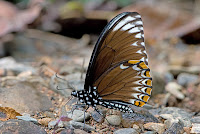 |
| Chiang Dao Nature Sanctuary, Thailand f.papone |
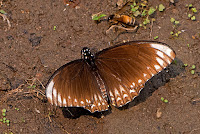 |
| Chiang Dao Nature Sanctuary, Thailand f.papone |
 |
| Chiang Dao Nature Sanctuary, Thailand f.papone |
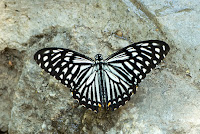 |
| Chae Son National Park, Thailand f.dissimilis |
 |
| Asystasia gangetica, a nectar source |
 |
| Chiang Dao Nature Sanctuary, Thailand f.dissimilis |
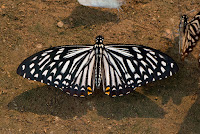 |
| Chiang Dao Nature Sanctuary, Thailand f.dissimilis |
 |
| the colourful late instar larva of Papilio clytia |
 |
| the unusually-shaped and camouflaged pupa |
 |
| Jatropha integerrima, another nectar source |
 |
| Chiang Dao Nature Sanctuary, Thailand f.papone |
 |
| Chiang Dao Nature Sanctuary, Thailand f.papone |
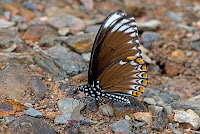 |
| Chiang Dao Nature Sanctuary, Thailand f.papone |
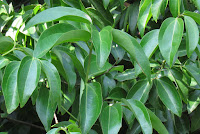 |
| Cinnamomum verum, a larval host |
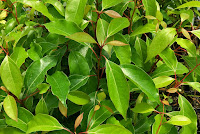 |
| Cinnamomum camphora, another larval host |
Links to other pages in this series for species in the same subfamily
Lamproptera meges
Papilio clytia
Papilio polytes
